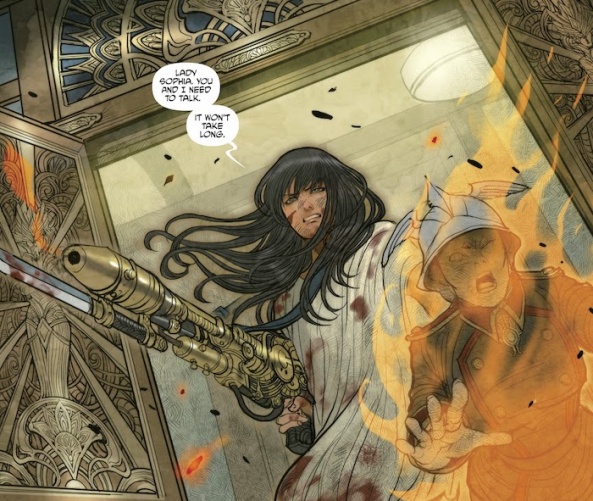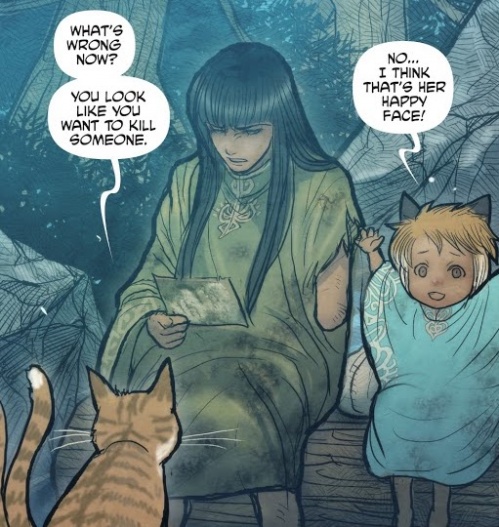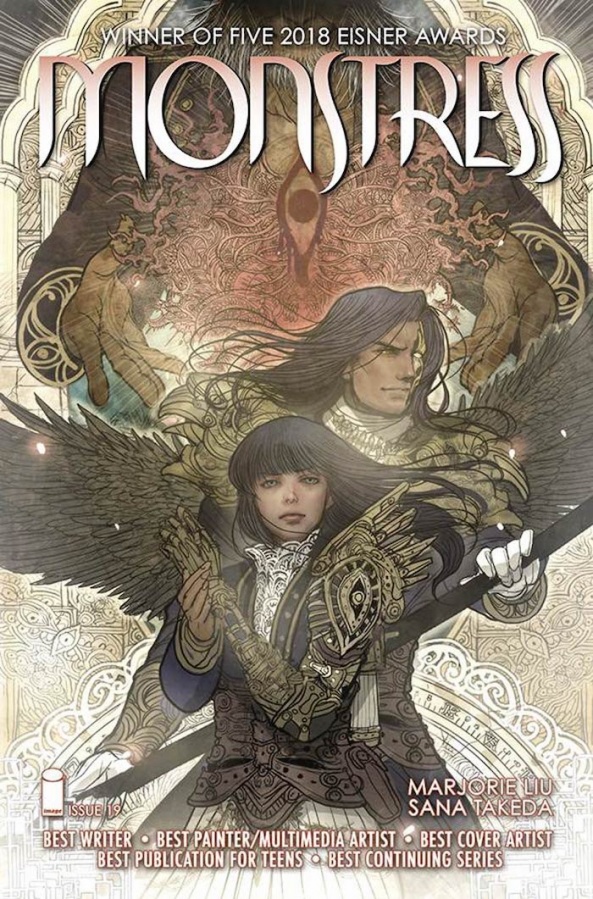There are a lot of comics out there, but some just stand out head and shoulders above the pack. With “Don’t Miss This” we want to spotlight those series we think need to be on your pull list. This week, we look at “Monstress,” the epic fantasy series that has won a great many awards ranging from the British Fantasy Awards to the Harvey Awards, to the Hugo Awards, to the Eisners, the latter of which they won five of in 2018 alone.
As a side note, “Monstress” is mature rated, and so has images, language, and themes that may not be suitable for young audiences.
Who Is This By?
Marjorie Liu is a New York Times bestselling author of urban fantasy and paranormal romance novels such as The Hunter Kiss and the Tiger Eye series. Her comic book work includes “NYX,” “X-23,” “Dark Wolverine,” and “Astonishing X-Men.” She has won multiple awards for “Monstress,” among them a 2017 Hugo Award and had the honor of being the first woman in the 30-year history of the Eisner Awards to win for Best Writer in 2018.
Sana Takeda has had a host of work for Image Comics and Marvel Comics, including work on “X-Men,” “Venom,” “Ms. Marvel,” and began her work with Marjorie Liu in the 2010 “X-23” series. Much like Liu, Takeda has garnered high praise for her work on “Monstress,” including two Eisner Awards and a Hugo Award in 2018.
What’s It All About?

Far from a traditional epic fantasy with high hopes, “Monstress” is definitely darker than many others, with Liu deriving elements of events that happened to her grandparents during World War II to mix in with the Asian fantasy elements, cosmic horror, and steampunk technology. These elements are emphasized in all of their intricacies by Takeda’s artwork, which can be absolutely beautiful and horrific in equal measure.
On the surface, the world of “Monstress” is awful, pure and simple. On the one hand, you have the humans and their Cumaea witch-nuns enforcing their will on the populace to the detriment of the part-animal Arcanics. On the other hand, we have the Arcanics themselves, who can be just as hostile toward humans due to a very long war.
Key to this conflict is the “Constantine” event, in which 140,000 people, human and Arcanic, were killed suddenly in some extreme show of power, leaving only seven Arcanic children alive and unharmed, one of whom is one Maika Halfwolf. These children are sought after by both sides to find out exactly what happened and how to use it to manipulate the war effort, which has halted into a cold war enforced by both sides assuming the other has information on the event, but neither truly knowing anything.

Caught in the middle of all of this, we have our protagonist, the aforementioned Maika Halfwolf. A human-looking Arcanic, both sides look down upon her, except for those who know exactly who she is. Calling her a protagonist is the best possible term, as she is definitely not any kind of traditional heroine. She does not fight for the rights of anyone else, nor does she care to do so for anything but her survival and that of the very few she shows affection toward, however slight. She is rude in the best of times, has no patience for authority, and to top it all off, has a literal monster, or “Monstra,” hidden deep within her body that comes out at the worst of times, including through her missing left arm, either feast on her enemies or attempt to do the same to her allies or even bystanders, regardless of age or her own consent.
That said, not all is purely doom and gloom. The supporting cast allows for a wide variety of reactions to Maika, from the nervous and youthful exuberance of Kippa, the young fox girl; to the sarcastic and enigmatic Master Ren, a feline manipulator of spirits, or “nekomancer.”
What Makes It So Great?

In wars such as this one, there is no pure good nor evil, with each side out to get what it wants, and innocents or otherwise neutral parties caught in the crossfire. All of the sides of the conflicts are shown, and there is so much gray area that in many cases, the story would probably be hard to stomach. However, it is a testament to the creative team that the story, in its elaborate, beautiful artwork and its intricate characters and relationships, that the story is thoroughly engrossing, rather than alienating for its audience. Nobody is perfect, and the violence seems inherent in the system, but through it all, through the dehumanization imposed on the Arcanics and the reactionary effect it has against humanity, through the way in which the war affects everyone, there is time to explore friendship amongst the women (who are roughly five to every man in this world) and how such a hostile environment can shape relationships.
Continued belowCharacter relationships and development truly make “Monstress.” The comedy is still there, at times black as pitch, at times light as air, but seeing how Maika and her companions survive in the ever-hostile world really helps to demonstrate how such an environment can shape all kinds of people, from the highest levels of authority to the lowest of peasants and beyond. A large part of the development comes from how heroism and benevolence are not necessarily the same thing, and how even the most heroic of actions may have a selfish aim.
How Can You Read It?

“Monstress” is available anywhere comic books are sold. The fourth arc begins today with “Monstress” #19 from Image Comics.
The series is released at six monthly issues a year, with a volume of that arc released soon afterwards. The first three arcs, ‘Awakening,’ ‘The Blood,’ and ‘Haven’ are available in paperback volumes, with a hardcover version containing all three arcs over eighteen issues set to be released on July 3rd.






